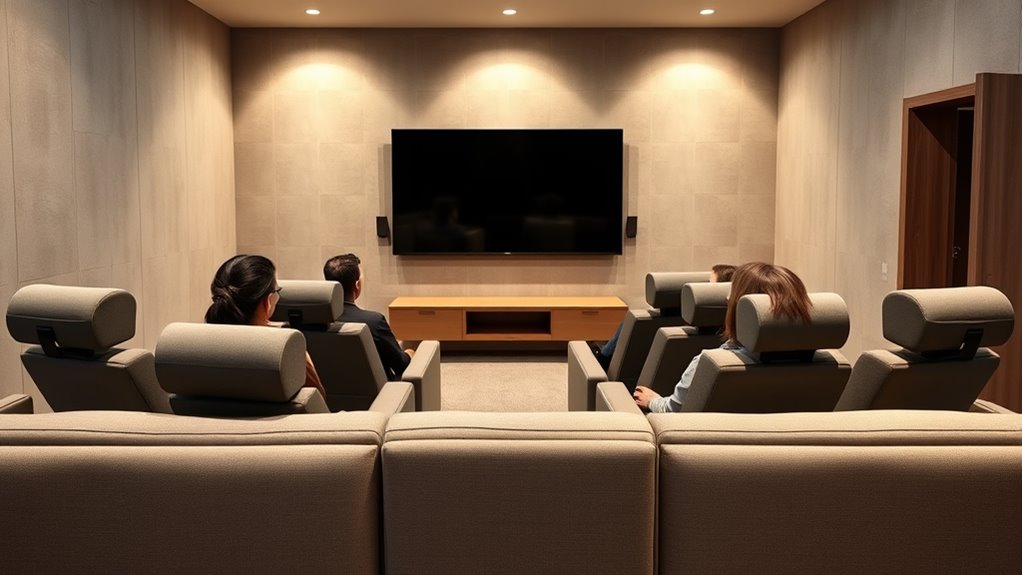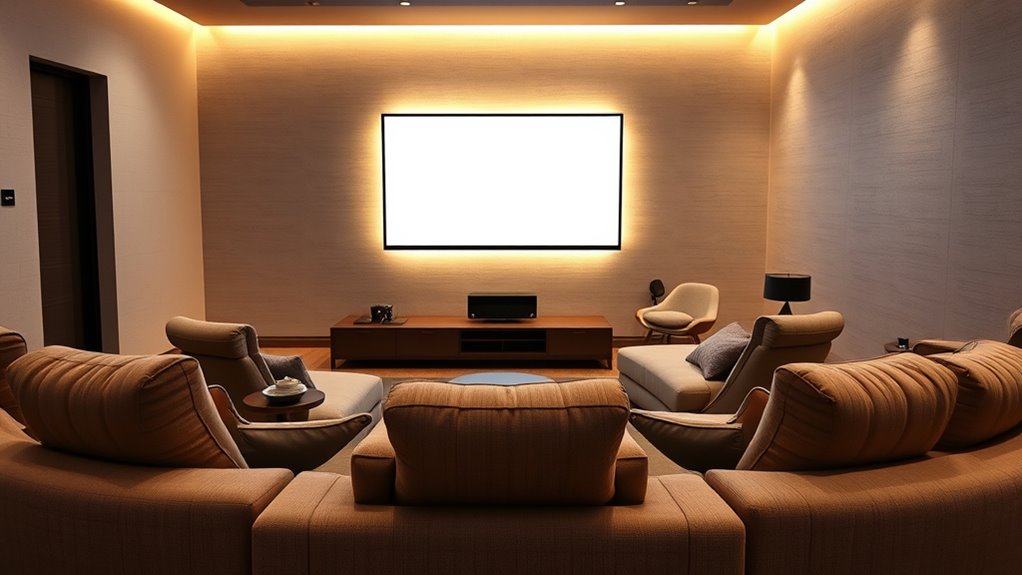To prevent neck pain in your TV room, position your screen so the center is at or just below your eye level when seated. Arrange your seating in a semi-circle or staggered pattern to keep your neck in a natural, relaxed position, and sit at a distance of 1.5 to 2.5 times the TV’s diagonal size. Fine-tuning your setup can make a big difference—keep exploring for more tips to create a truly ergonomic space.
Key Takeaways
- Mount the TV so the screen center is at or just below eye level when seated.
- Maintain a viewing distance of 1.5 to 2.5 times the TV’s diagonal size for comfortable neck positioning.
- Arrange seating in a semi-circle or staggered pattern to minimize neck turning and promote relaxed postures.
- Use ergonomic chairs that support upright sitting and help keep the neck in a neutral position.
- Regularly adjust screen height and seating layout to ensure natural, strain-free viewing angles for all viewers.

Spending long hours in your TV room shouldn’t mean ending the day with neck pain. The key to a comfortable viewing experience lies in proper screen height and seating arrangement. When your TV is positioned too high or too low, you naturally tilt or crane your neck, which can lead to discomfort or even chronic pain over time. To prevent this, you need to ensure that your screen is at eye level when you’re seated comfortably. This means the center of your TV screen should be roughly at or just below your eye line, allowing you to look straight ahead without tilting your head up or down. If you’re using a large flat-screen TV, consider mounting it on the wall at the correct height, or placing it on a stand that elevates it to the right level. Avoid placing the TV too high above eye level, which causes you to look up constantly, or too low, which forces you to look down and strain your neck.
Once you’ve sorted out the screen height, the next step is to focus on your seating arrangement. Your sofa or chairs should be positioned at a comfortable distance where you can see the entire screen without leaning forward or stretching your neck. A good rule of thumb is to sit about 1.5 to 2.5 times the diagonal size of your TV away from the screen. For example, if you have a 55-inch TV, sitting roughly 6.5 to 11 feet away offers an ideal viewing angle. Keep in mind that your seating should support good posture—sit upright with your back fully supported and feet flat on the floor. Avoid slouching or reclining in a way that causes you to turn your head repeatedly or adopt awkward positions. If your seating area is too close or too far from the screen, you might find yourself craning your neck or squinting, which puts unnecessary stress on your cervical spine. Additionally, incorporating ergonomic seating can further help reduce neck strain during long viewing sessions.
Additionally, consider how the seating map in your TV room can be enhanced for multiple viewers. Arranging seats in a semi-circle or staggered pattern can help everyone maintain a comfortable viewing height and distance. If multiple people watch together, make sure each spot allows for a natural, relaxed neck position. Remember, the goal is to create a space where your eyes naturally meet the center of the screen without strain. Small adjustments in screen placement and seating layout can considerably reduce neck fatigue, making your TV time more enjoyable and pain-free. Proper planning and attention to these details ensure that your TV room becomes a space for entertainment, not discomfort.
Frequently Asked Questions
How Can I Adjust My TV Room for Multiple Viewers?
To adjust your TV room for multiple viewers, arrange seating at different angles and distances to guarantee everyone has a clear view. Use adjustable chairs or sofas to accommodate various heights and preferences. Place the TV at an ideal height—eye level when seated—and consider adding swivel chairs or modular furniture. This setup helps everyone comfortably enjoy the screen without neck strain or awkward positions.
What Are the Best Ergonomic Chairs for Long Viewing Sessions?
You need ergonomic chairs that support long viewing sessions and keep you comfortable. Look for chairs with adjustable height, lumbar support, and a breathable mesh back for airflow. Swivel bases and padded armrests also boost comfort. While sleek designs might look good, prioritize function. An ergonomic chair like the Herman Miller Aeron or Steelcase Leap offers excellent support, so you can enjoy your shows without neck or back strain.
How Does Lighting Affect Neck Strain in TV Rooms?
Lighting plays a key role in reducing neck strain during TV viewing. Bright, even lighting minimizes glare on the screen, helping you avoid leaning forward or tilting your head. Soft ambient light reduces eye strain, allowing you to sit comfortably without craning your neck to see better. By balancing ambient and task lighting, you create a comfortable environment that keeps your neck relaxed and prevents tension during long viewing sessions.
Are There Specific Screen Sizes Ideal for Minimizing Neck Pain?
Choosing the right screen size can markedly reduce neck pain. Opt for a screen that’s large enough to view comfortably from your seating distance, typically 40 to 55 inches for most living rooms. Avoid screens that are too small, which make you crane your neck, or excessively large, which force you to turn your head constantly. Find a balance that keeps the screen within your natural eye level, promoting comfort and reducing strain.
What Common Mistakes Cause Neck Discomfort in TV Room Setups?
You often cause neck discomfort by placing the TV too high or low, forcing you to crane or tilt your neck unnaturally. Sitting too close or too far from the screen strains your neck and eyes. Also, ignoring proper seating support and slouching can lead to tension. To avoid this, set the screen at eye level and maintain good posture, ensuring your spine stays aligned during viewing.
Conclusion
By adjusting your screen height and seating position, you can keep your TV room comfortable and neck pain free. Don’t wait for discomfort to take hold—take control now and create a space that works for you. Remember, a stitch in time saves nine; a little effort today guarantees you won’t be paying for it later. So, tune into your setup and enjoy your favorite shows without the ache. Your neck will thank you!









